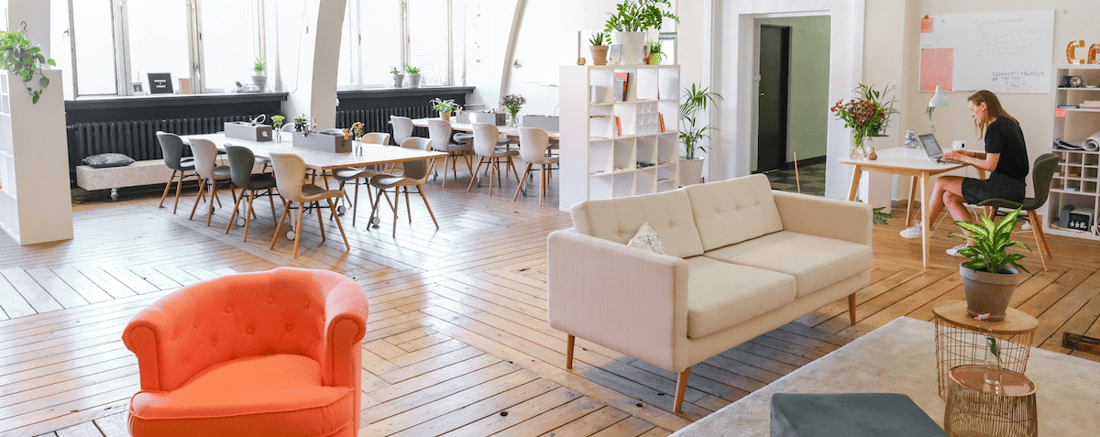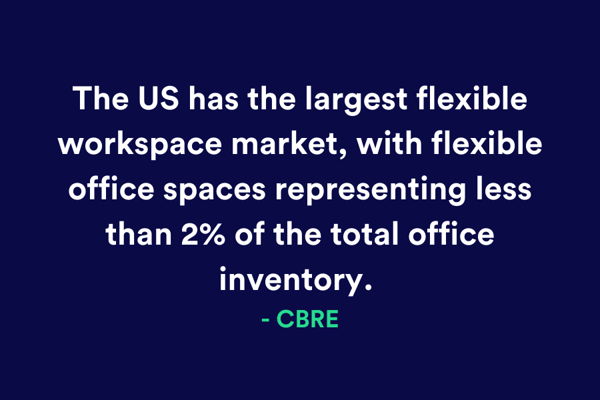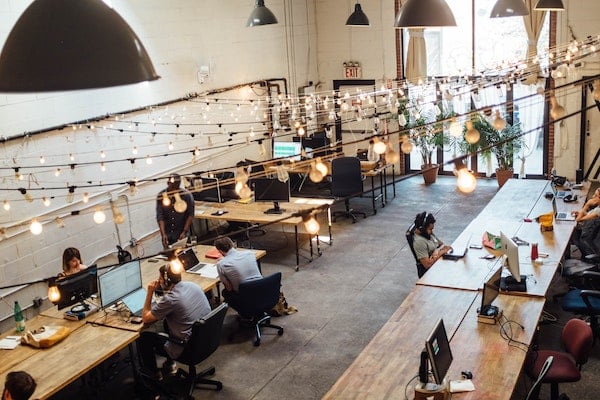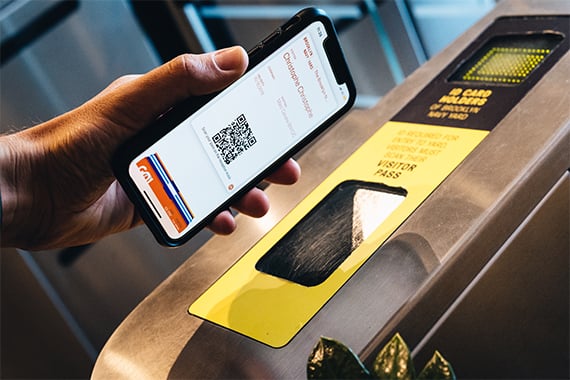The new world of work and the flex space 'renaissance'

This year, we were forced to reevaluate how we work and what matters most when it comes to our workspaces.
Remote work is a default solution as companies figure out how to reconfigure and introduce new technology into traditional offices to meet health and safety requirements. As such, flex spaces are reinventing themselves and gaining popularity as an alternative workspace that facilitates collaboration, relationship building, and innovation.
A shift toward flexible workspaces may help companies move forward in this pandemic era, as well as address the fact that how and where people work may no longer meet their needs. As people expect and deserve to be happy and safe at their workplace, some companies have already created their own flexible work strategies and put them to test.
Let's take a closer look at what exactly flex spaces are, why they're experiencing a renaissance, and how they could reshape the modern work environment.
What is flex space?
Flex space allows businesses to access flexible office spaces in multiple locations on a short-term lease from one month to three years. Flexible spaces are usually managed by flex workspace companies, individual landlords, or via partnerships between the two.
Flex spaces include co-working spaces, serviced offices, and also hybrid offerings that cater to corporations. A common characteristic is their multipurpose design, which provides great adaptability and increased engagement and productivity among employees.
Generally, these workspaces have the following essential features:
- Open plan concepts facilitating collaboration and communication within the workspace
- Breakout spaces encouraging working in smaller groups.
- Quiet zones for tasks that require deep concentration or for quick calls and meetings.
- Touchpoints providing a fixed workspace for additional staff and temporary employees.
- Shared resources, everything from the office equipment to lunchrooms and other amenities available on the premises.

A recent report by CBRE revealed that the US has the largest flexible workspace market, with flexible office spaces representing less than 2% of the total office inventory. Moreover, the dominant flex-space operator is WeWork, with 33% of US flexible space, followed by Spaces, Knotel, and Industrious.
How do flex spaces work?
In contrast to the traditional workspaces, flexible spaces can easily support businesses through their different development stages, whether they're scaling up, downsizing, de-densifying, or decentralizing.
The key idea behind flex spaces is that flexible architecture and design can help people work efficiently by offering them multipurpose, dynamic built environments.
Similar to how living organisms behave, these offices can respond to external changes and adapt to new needs. Following this idea, a flexible workspace can be a conference room, a collaboration space, or a quiet zone, depending on the needs of the employees who use it at the time.
Shape-shifting design can empower people and companies while providing them with interactive working environments that they can modify without the need for complex and time-consuming renovations.
The magic of flexible spaces lies in details like sliding walls that double as storage, creatively-built foldable desks, or even reconfigurable ceilings that offer increased control over the workspace’s acoustics.

Flex spaces allow businesses to disperse their workforce and minimize daily commutes by having different office locations spread across the city in the areas where their employees live.
What are the main benefits of flex spaces?
As more companies begin experimenting with flex space, several advantages are being brought into the spotlight.
1. They boost employee well-being and collaboration.
When remote work became the norm for many overnight, employees without home offices had to transform their bedrooms, living rooms, or even kitchens into makeshift offices. Add that to family distractions, Zoom fatigue, and lack of face-to-face collaboration with colleagues, the situation has proved to be increasingly difficult for many.
Flexible spaces allow companies to provide employees with workspaces near their homes where they can work on solo or team projects, while feeling safe and comfortable (as long as the right health and safety measures are put into place). The use of biophilic design in modern flex spaces also helps to improve individuals' mental health and productivity.
2. They’re highly adaptable, even in crises.
Like many traditional offices, flex spaces had to undergo de-densification of desks and reconfiguration of common areas and meeting rooms, but their design has facilitated this process.
These changes we see, together with technologies that fuel contactless and safe environments, are being woven into the creation process of future flexible spaces.
Companies struggling to bring back employees due to unsafe office design issues could benefit from investing in flex spaces, rather than taking on the grueling task of redesigning each floor from scratch.Companies will realize they don’t need all of this fixed space. They can get employees to work from home part of the time, and work from flex spaces part of the time. I think the biggest thing we’ve been seeing for a while now is this movement towards flexibility and how stakeholders like landlords will accommodate for that. - Tashi Dorjee, Senior Director and Flexible Space Solution Lead, JLL
3. They are a sustainable, long-term solution.
Another vital benefit of flexible workspaces is the positive impact they have on the environment. Flex spaces are built with a considerable amount of forethought when it comes to people's needs, which can change drastically every 10-15 years (or suddenly, due to crises like a global pandemic).
Once a building stops being relevant and useful for its occupants, it usually undergoes extensive reconstruction or even demolition, which results in enormous amounts of waste.
Modular, sustainable designs of flexible spaces allow companies to modify workspaces without creating more waste, or spending vast amounts of money on reconstruction or renovation.
4. They reduce overhead costs.
Flexible spaces allow some companies to avoid the commitment of a traditional long-term lease contract and the incurred operational expenses that result from it.
A recent study revealed that flexible workspaces are more budget-friendly than renting traditional office space in major cities. However, as is typical with commercial real estate, costs of flex spaces can vary from market to market, location to location, and provider to provider.
In addition, in contrast to traditional leases, co-working spaces come with all the basics (i.e., printing equipment, office furniture, Wi-Fi & phone services, utilities, and event spaces, and often other additional amenities) included in their subscriptions.
A lot of landlords also see flex space as an opportunity to retain their tenants. They (tenants) get access not only to many floors in their building, but also to beautiful flexible spaces with food and beverage offerings and a lounge. - Tashi Dorjee, Senior Director and Flexible Space Solution Lead, JLL
Where does workplace tech fit into today's flex space environment?
Smart technologies like cloud visitor management systems (VMS) have been essential in screening and tracking individuals on the premises, allowing companies to safely reopen to welcome employees and visitors.

VMS also seamlessly integrate with building access control systems, create a touchless check-in experience to lower risks of the spread of the virus, and help keep individuals' data private. All of this makes it easier for flexible space managers to meet changing pandemic guidelines, and better manage people flows in their offices at all times.
The future of work is flexible
We'll continue to witness the regeneration and evolution of flex spaces is as we learn to adapt to new working norms.
In periods of uncertainty, businesses that use flex workspaces could cut costs and improve the employee experience. But for some, this comes with a greater change in organizational culture.
So many of the discussions I’ve had in the last 12 weeks centered around everyone needing to work from home, or everyone needing to remain in the office. And the answer is, it’s not a binary choice. It doesn’t have to be one or the other. - Kay Sargent, Senior Principal - Director of WorkPlace, HOK
Companies will need to grant their employees more freedom and flexibility to choose when and where they work if they want to keep their workforce engaged, productive, and, most importantly, healthy.
Hear more about the new world of work and how to prepare for a safe office return from expert speakers at our Return Ready Virtual Summit. Watch full session replays now.



